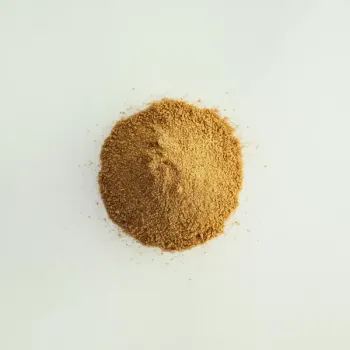Turmeric and Ground Cumin are spices with distinct properties; Turmeric offers a bright yellow color and a bitter taste, while Ground Cumin provides an earthy flavor with a hint of citrus, popular in various cuisines for their unique contributions to dishes.

Turmeric is a bright yellow spice known for its warm, bitter taste and a key ingredient in curry powders. It's derived from the rhizome of the Curcuma longa plant and has been used for centuries in cooking and traditional medicine.

Ground Cumin is made from the dried seeds of the Cuminum cyminum plant, often used in cuisines around the world for its earthy, nutty, and slightly peppery flavor. It's a cornerstone of many spice blends, including taco seasoning and garam masala.
While both spices are integral in various cuisines, Turmeric is known for its vivid yellow color and a slightly bitter, gingery taste. Ground Cumin, on the other hand, has a darker hue and offers a warm, earthy flavor with a hint of citrus. Turmeric is often used for its coloring and potential health benefits, whereas cumin is valued for its distinctive taste.

Your ultimate Recipe Box, Meal Planner, and Cooking Class all in one
In curries, Turmeric provides a robust color and a subtle flavor foundation. It's best used in dishes like turmeric chicken curry or aloo gobi for a mild, earthy undertone and vibrant color. Ground Cumin brings a depth of flavor to curries such as Rogan Josh or Dal. It's essential for creating the complex taste profiles characteristic of many Indian and Middle Eastern dishes.
When used in spice rubs, Turmeric offers a subtle bitterness and color to meats such as baked chicken or grilled fish. It pairs well with other spices without overpowering the dish. Ground Cumin is a popular choice in rubs for grilling or roasting meats, particularly beef or pork. Its earthy flavor stands up well to high heat and complements the savoriness of the meat.
In soups and stews, Turmeric acts as a background note, enhancing other flavors. Try it in lentil soup or vegetable stew for an added layer of complexity. Ground Cumin's robust flavor makes it a favorite in hearty stews and chili. Its boldness enriches the overall taste profile and adds a punch to every spoonful.
Turmeric is renowned for its curcumin content and potential anti-inflammatory properties, while Cumin is a good source of iron.
| Nutrient | Turmeric ( per Teaspoon ) | Ground Cumin ( per Teaspoon ) |
|---|---|---|
| Fat | 0.1g | 0.47g |
| Iron | 1.65mg | 1.39mg |
| Protein | 0.31g | 0.37g |
| Calories | 9 | 8 |
| Manganese | 0.517mg | |
| Carbohydrates | 2g | 0.93g |
It's not recommended as a direct substitute due to their distinct flavors. However, for color and a milder taste, Turmeric can be used.
Both have health benefits. Turmeric contains curcumin with anti-inflammatory properties, while Cumin is rich in iron.
Turmeric has a bitter, slightly ginger-like taste, whereas Ground Cumin is earthy, nutty, and has a hint of citrus.
Ground Cumin cannot replicate the bright yellow color of Turmeric, but it can add a warm, golden hue to dishes.
Turmeric is great in curries, rice dishes, and soups for color and a mild flavor. Ground Cumin excels in spice rubs, stews, and any dish where a warm, earthy spice profile is desired.